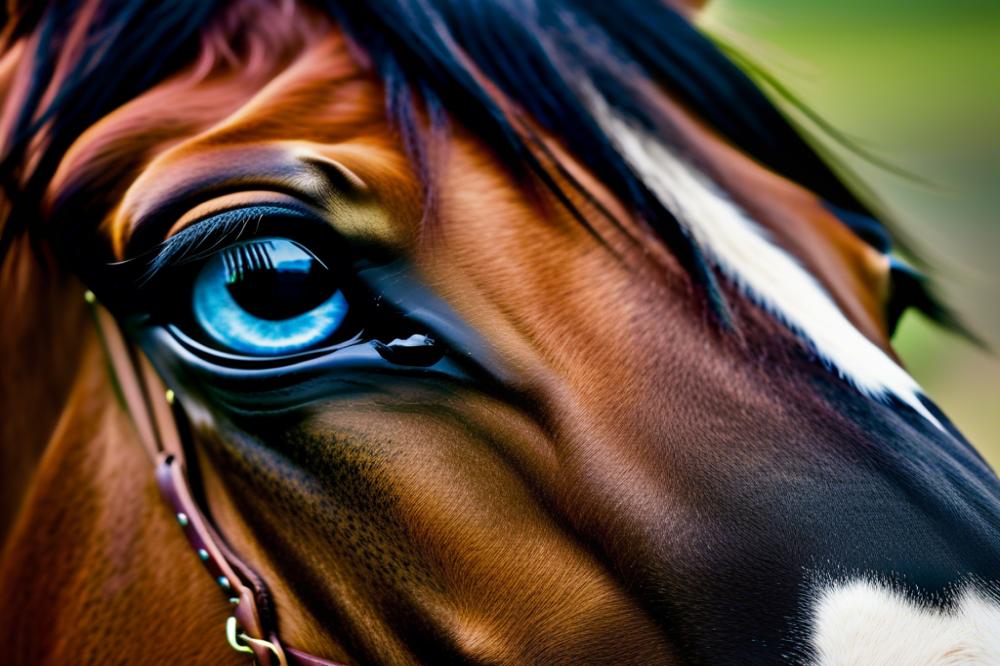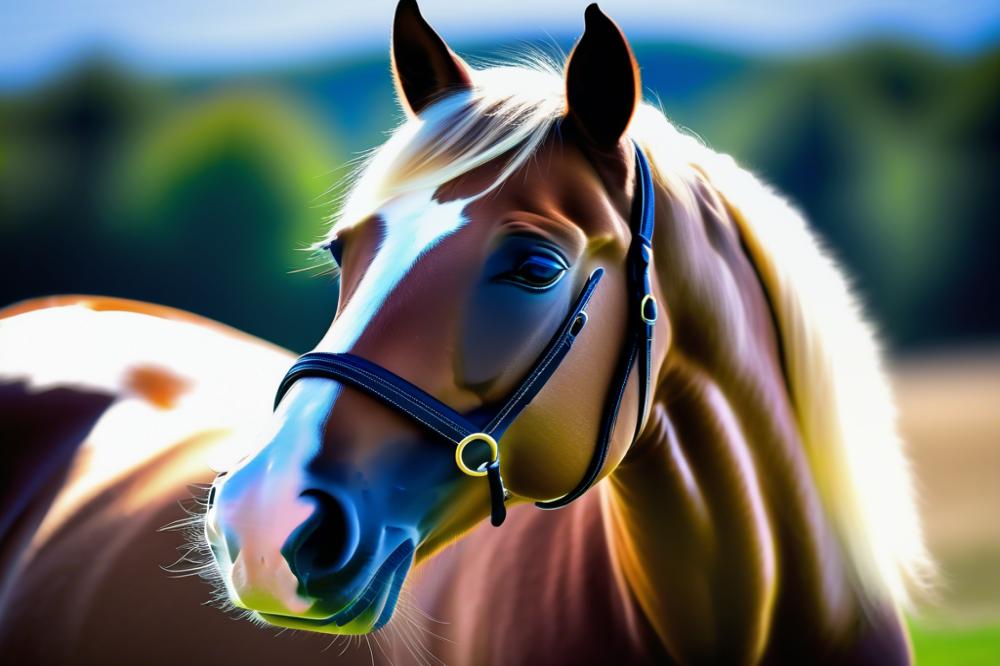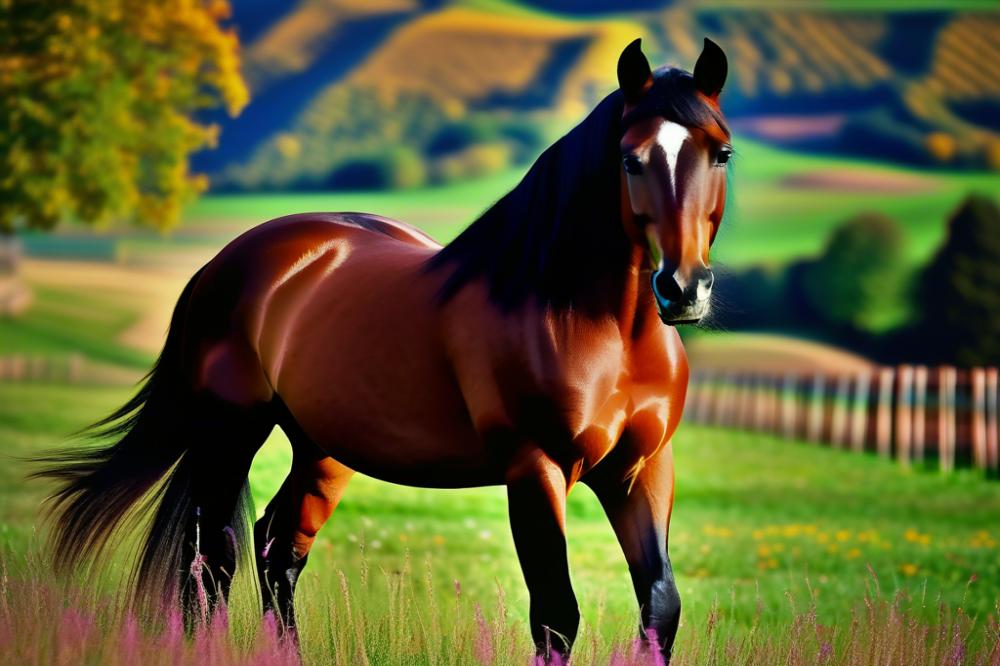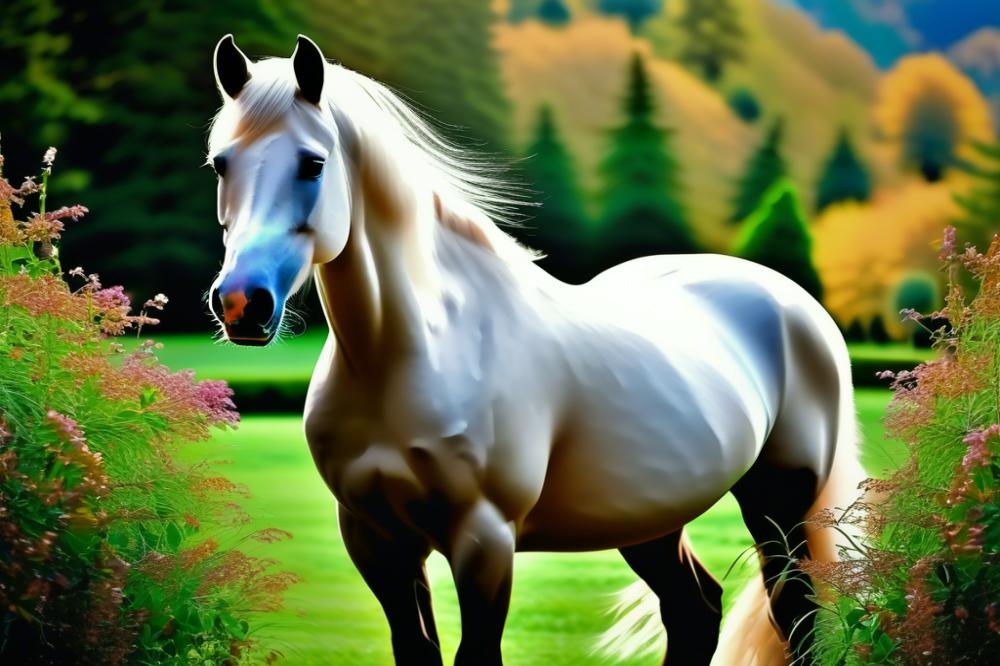Exploring the Allure of Horses with Blue Eyes
When you think of eye-catching features in horses, blue eyes often come to mind. These striking equine characteristics draw our attention, making these animals appear almost magical. After all, it’s not every day you see a horse that seems to gaze right into your soul with those deep blue pools of color!
Many people wonder about the significance of blue eyes in horses. Some think it just adds to their beauty, while others speculate on the genetics behind those astonishing peepers. Aberrant colors in the animal kingdom are usually the result of unique genetic traits. In horses, blue eyes can occur in specific breeds and are sometimes linked to certain coat patterns, such as pinto or almost white coats. This fascinating eye color can also be a topic of conversation when discussing horse breed information.
The purpose of this article is not just to amuse you with images of horses with beautiful blue eyes. We want to delve into the intriguing world of these breeds, explore their personality traits, and touch on essential aspects of horse care that every owner should consider. Preparing horse enthusiasts with the knowledge they need will help them understand more than just what meets the eye—pun intended!
Whether you’re at a lovely event like the Camperdown Racecourse or simply enjoying a day at the barn, horses with blue eyes certainly make an impression. It’s like seeing a winged horse soaring through the clouds—you can’t help but look up and admire their charm. Join us as we journey through the fascinating realm of horse breeds that show off this captivating trait!
Understanding Blue Eyes in Horses

Genetic Factors Influencing Blue Eye Color
Blue eye color in horses is often linked to specific genetic factors. The genes that control pigmentation are the same ones that affect eye color. For example, some horse breeds inherit a gene called ‘frame overo’, which can lead to blue eyes. This gene disrupts how pigment is produced. As a result, some horses with this gene may have one or both eyes appearing blue. Other times, it’s merely a matter of lack of pigment in the eye. No pigment means no color, and that can lead to those striking blue irises.
Common Myths and Misconceptions
Many people believe that blue-eyed horses have poor vision. In truth, having blue eyes doesn’t automatically mean vision issues. Horses with blue eyes can see just as well as their darker-eyed friends. Another misconception relates to temperament. Some folks say that blue-eyed horses are more temperamental or behaviorally different. There’s no solid evidence for this claim. Just like humans, a horse’s personality is more about their upbringing and training than their eye color. So, if you see a blue-eyed horse, don’t assume they’re a handful just because of their peepers!
Differences Between Blue Eyes and Other Eye Colors
There’s a notable contrast between blue eyes and other horse eye colors. Dark eyes tend to absorb more light, which helps with depth perception. Blue eyes, on the other hand, reflect light differently. This difference can impact how they respond to bright conditions. It’s not just about looks; colors can potentially influence behavior, too. For example, horses can become startled more easily in brightly lit situations if they happen to have those bright blue eyes. Understanding these equine characteristics helps with horse care. Each horse is unique in their way, and recognizing these traits enables better treatment for all breeds.
Blue-Eyed Horse Breeds

Did you know there are some stunning horse breeds with blue eyes? Well, they exist, and they sure grab attention. Let’s take a look at some of the most notable ones.
Appaloosa
The Appaloosa is known for its colorful coat patterns, but don’t overlook those striking blue peepers! These horses often have a lively personality, following you around like a playful puppy. Their unique spots can range from a few freckles to a full coat of color, making every Appaloosa a true individual. Horse care is pretty important, especially for these guys—they benefit from regular grooming to keep their coat in top shape.
Paint
Next up is the Paint horse. They are well-loved for their stunning coat designs, often resembling a beautiful patchwork quilt. Blue eyes can often be seen on these beautiful animals, adding an extra charm. These horses are known for their gentle temperaments, making them perfect companions for riders of all ages. Additionally, their athleticism shows in many disciplines, from rodeo to dressage. So, if you’re looking for horse breed information, you can’t go wrong with a Paint.
Quarter Horse
Now, let’s talk about the Quarter Horse. This breed is like the all-rounder of equine characteristics. Known for their speed and agility, these horses often have blue eyes that stand out beautifully against their muscular frames. They excel in various areas, from racing to ranch work, showing off versatility like none other. Regular training and socialization help keep their spirits high, and a good diet keeps them healthy and shiny.
Arabian
The Arabian horse is truly a classic. They are not only one of the oldest breeds but also one of the most recognizable. These horses can sport beautiful blue eye colors that seem to shine with wisdom! You can find them in various colors, but those blue eyes add an extra flair. Known for their endurance and grace, Arabians also have personality to spare. They form strong bonds with their owners, almost like extra family members. Caring for them requires understanding their needs and providing proper exercise.
Clydesdale
Last but not least, we have the Clydesdale. These big beauties are famous for their size and their long legs, which make them look almost like gentle giants. Many Clydesdales have striking blue eyes that capture your heart. Their friendly demeanor makes them great for families and shows. Being a draft horse, they also require specific horse care, so keeping them fit and happy is important. If you’ve ever seen those commercials with Clydesdales, you know how charming they can be!
So, among these horse breeds, blue eyes can really stand out. Whether it’s the spirited Appaloosa or the majestic Clydesdale, each breed comes with its own special traits. Keep an eye out—you might just meet a blue-eyed beauty!
Genetic Considerations

Understanding how blue eyes show up in horses takes us straight into genetics. You might think it’s as simple as a paint job, but it’s way more complicated than that! The color of a horse’s eyes comes from the genes it inherits from its parents. These genes are like little instruction manuals that tell the horse’s body how to develop.
One significant player in this genetic drama is the splash gene. This particular gene doesn’t just influence coat patterns; it also impacts eye color. Horses with this gene can have striking blue eyes. Other genetic elements play their part too. For instance, certain combinations can create the right conditions for those dazzling azure peepers to appear. It’s all like a grand puzzle where each piece matters.
Now, let’s talk health. Some horse breeds with blue eyes may face unique challenges. Having blue eyes isn’t just about looking pretty; it can come with some risks. Horses with lighter-colored eyes sometimes have less pigment to protect against harsh sunlight. This can lead to conditions like sunburn or even skin cancer in some cases. Horse care must account for this, as owners should look into UV protection for their equine companions. Sunscreen for horses? You bet!
It’s a balancing act. Breeders need to understand how these genes work together and what they mean for the overall health of their horses. Protecting the eyes of horses is essential, especially for those sparkling blue beauties. Equine characteristics often go beyond mere looks. They encompass health, temperament, and even life expectancy.
So, next time you see a horse with captivating blue eyes, remember there’s more than meets the eye. Genetics, health care, and a bit of breeding know-how come together in a fascinating way. Blue eyes might seem rare, but they bring along a whole world of responsibility for those who love and care for these majestic animals.
Caring for Blue-Eyed Horses
Horses with blue eyes bring a special charm to the stable. However, these beautiful creatures often require a bit more care compared to their darker-eyed counterparts. Regular attention to their needs can make a significant difference in their overall health.
Specific Care Requirements
The first step is to recognize the specific equine characteristics of blue-eyed horse breeds. Light sensitivity is a common issue. They might squint in bright sunlight or struggle more when exposed to glare. Keeping their environment comfortable helps a lot.
Providing shade can be beneficial, especially during warm weather. Shade structures or trees can offer relief from the harsh sun. Be mindful about their surroundings. Adding a fly mask, designed for UV protection, can shield their eyes from intense sunlight. It’s like giving them stylish sunglasses!
Sensitivity to Light and UV Protection
Many folks don’t realize that blue-eyed horses might have extra sensitivity to UV rays. Much like sunburn for us, these rays can cause irritation or even long-term damage. Therefore, always prioritize protection during high sun exposure. Bright days need special attention.
Grooming isn’t just for looks; it plays a significant role. Brushing helps to keep their coats healthy and can help in maintaining eye health, too. Don’t forget to check their living quarters for sharp objects or debris that could pose a risk to those lovely blue eyes. Safety first!
Regular Eye Examinations and Health Checks
Regular eye examinations are essential, not just for fun. Like humans, horses need to see clearly to thrive. Every few months, take a close look at their eyes. Watch for any signs of discomfort or changes in appearance. Cloudiness or excessive tearing may indicate underlying issues.
Health checks should be holistic too. A good diet, tailored to their specific breed, can keep their eyes bright and clear. A balanced diet supports their overall well-being and maintains the glow in their unique eye colors.
A veterinarian can provide invaluable horse breed information when it comes to proper eye care. Don’t hesitate to ask questions during appointments. It can help you learn even more about those gorgeous blue eyes!
Cultural Significance and Representation
Representation of Blue-Eyed Horses in Art and Culture
Blue-eyed horses have caught the imagination of many artists throughout history. Paintings, sculptures, and even folklore often highlight these striking equine characteristics. A blue-eyed stallion might symbolize mystery, beauty, or wild spirit. In art, the vivid contrast of these eyes against the horse’s coat captures attention right away. Famous pieces sometimes feature these enchanting creatures in a way that makes them almost dreamlike. Their appearance brings out certain emotions, stirring an awe that ordinary horses may not evoke.
Folklore and Beliefs Surrounding Blue-Eyed Horses
Different cultures have developed fascinating myths about horses with blue eyes. Some believe these animals possess magical powers or bring good luck. Stories from various regions describe blue-eyed horses as guides or protectors in times of trouble. In certain traditions, they are seen as mystical beings that can connect the earthly world to the spiritual realm. Imagine hearing tales around a campfire, where a blue-eyed horse saves a lost traveler with its otherworldly charm. Such narratives add a layer of enchantment to the allure of these animals.
Popularity and Perception in Equestrian Communities
Within equestrian circles, blue eyes attract a lot of attention. Horse breeds that show this eye color often draw enthusiastic admirers at shows and events. Riders sometimes claim that these horses have a special connection with their handlers. They may believe that the blue eyes reflect an insightful and sensitive nature. Care for these unique creatures doesn’t deviate much from standard horse care practices, but their special look certainly makes them stand out. Folks chatter about their presence, sharing experiences and opinions.
One might find discussions about blue-eyed horses thrilling and captivating. Among enthusiasts, there’s a tendency to celebrate the unusual with admiration. Some even joke that anyone who owns one has a golden ticket to a special horse club! Perceptions range from admiration to awe, and the fascination continues to grow. In this vibrant community, blue-eyed horses are indeed a topic that gets hearts racing and eyes sparkling.
Famous Blue-Eyed Horses
In the world of horses, some sparkle a bit more than others. Among them, blue-eyed horses have a charm that captures hearts. Let’s take a look at some famous horses with blue eyes that have trotted into history and modern times.
Notable Horses Through Time
One of the most famous blue-eyed horses is the stunning Kiger Mustang. Known for its remarkable endurance, this breed has roots that go back to the wild horses of the American West. Not only do they have striking blue eyes, but they showcase incredible equine characteristics as well. Another standout is the Gypsy Vanner. These horses are not just pretty faces; their unique eye colors and beautifully patterned coats have made them favorites in parades and shows.
Contributions to the Equestrian World
These blue-eyed beauties have made important contributions, too. The Kiger Mustang stands tall as a symbol of American heritage. Their spirit and resilience remind people of the wild beauty of untamed lands. Gypsy Vanners, on the other hand, have gained popularity for their calm temperaments. More than just attractive, they excel in various disciplines like dressage and driving.
Anecdotes and Stories
Once, there was a blue-eyed Arabian named Bluebell who stole the spotlight at a local fair. People gathered just to get a glimpse of her piercing gaze. It’s said that a photographer snapped her picture so many times that she became somewhat of a ‘model’ among horses. Another story involves a thoroughbred filly named Sky. She had big dreams of racing but spent her days lounging in the pasture. Her laid-back attitude certainly fascinated everyone, showing that not all blue-eyed horses are in a hurry.
Horse care requires special attention, especially for those with unusual traits like blue eyes. Whether it’s protecting their sensitive skin or ensuring their eye health, owners often go the extra mile. The quirks and stories of these captivating horses remind us of the joy they bring to our lives. Each blue-eyed equine has its own story, rich with charm and character.
Wrapping It Up
As we draw this journey to a close, let’s recap some key points about those fascinating horses with blue eyes. First off, these horses aren’t just beautiful; they come in various breeds, showcasing a range of characteristics that make them stand out in any setting. From their striking appearance to their unique dispositions, it’s clear that blue-eyed horses capture the hearts of many enthusiasts.
Beauty is something that speaks to us all, and there’s no denying the allure of a horse’s bright blue gaze. Imagine standing next to a magnificent animal, looking deep into those cerulean eyes, and feeling like you’ve just unlocked a fantastic secret of the equine world. With colors ranging from the shimmering grays of an Arabian to the robust coats of a Quarter Horse, these horses remind us just how diverse and wonderful nature can be.
For anyone who has experienced the thrill of endurance riding, the bond between rider and horse becomes even more profound. They are not only partners in competition but also companions on life’s journey. After all, nothing compares to the feeling of a horse licking me as if to say, “I’ve got your back.” It’s those little moments that create lasting memories.
Let’s take a moment to appreciate how special these extraordinary creatures are. They symbolize a blend of strength, grace, and just a touch of whimsy. So the next time you encounter a blue-eyed horse, take a moment to admire its beauty. These animals remind us of the magical connection we can have with the natural world. Keep your eyes open for these lovely creatures, and you might just find a new appreciation for the majestic equines that dot our landscapes.



